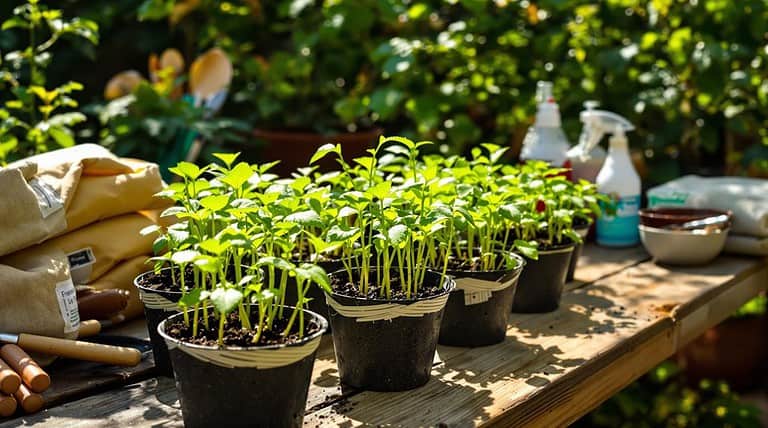How To Kill Virginia Creeper
Are you struggling with an overgrown Virginia Creeper vine, Parthenocissus quinquefolia, taking over your garden? You are not alone. This blog post offers detailed strategies to kill Virginia Creeper and reclaim your green space. Discover multiple methods to eradicate this woody vine that climbs relentlessly, smothering other plants. From effective herbicides to careful pruning techniques, we present the most effective ways to kill Virginia Creeper and keep it from growing back.
Understanding the Virginia Creeper Vine
Virginia creeper (Parthenocissus quinquefolia) is a perennial woody vine native to eastern and central North America. Known for its aggressive growth, the vine displays five leaflets (“quinquefolia” means five-leaved) and has tendrils with adhesive tips, enabling it to climb fences, shrubs, and even tall trees. Its leaves turn bright red in fall, producing clusters of blueberries that are toxic to humans but a food source for birds. Although some gardeners purposefully plant Virginia creeper due to its ornamental nature, others struggle to control it as it can quickly become a pesky vine.

Why Does Virginia Creeper Need Controlling?
Despite its ornamental foliage that can turn bright red in fall, the Virginia creeper vine grows so aggressively that it can take over your garden and smother other plants, depriving them of sunlight and nutrients. A thick layer of mulch can help control this vine, but sometimes it is not enough, and the gardener must find a way to kill Virginia creeper. Moreover, the plant’s sap can irritate the skin, much like poison ivy, and the blueberries it produces are toxic to humans, creating a potential risk in gardens frequented by children or pets. (Learn How Much Water Do Marigolds Need)
Is Virginia Creeper the Same as Poison Ivy?
Although Virginia creeper and poison ivy may cause skin irritation, they are distinct species. The Virginia creeper is often mistaken for poison ivy due to their similar leaf structures, both growing as a vine or ground cover. However, poison ivy has three leaflets, while Virginia creeper typically has five. So, while controlling Virginia creeper may not require as much caution as poison ivy, it’s still essential to wear gloves when handling the plant.
What are the Physical Methods to Get Rid of Virginia Creeper?
The best way to kill Virginia Creeper physically is by cutting and removing the vines. Simple hand pulling might be sufficient for small plants growing along the ground, especially when wet. For more giant vines, you may need to use pruning shears to cut the vine back and dig out the underground root system to prevent the vine from regrowing. Ensure you dispose of the cut vines properly, as they can root from the cut stem and start new growth.
How to Prune and Cut the Virginia Creeper Vine?
To physically remove the Virginia creeper, cut the vine as close to the ground as possible, and wear gloves to avoid skin irritation. Once you cut the vine, apply a herbicide to the cut surface to kill the root system and prevent the vine from regrowing. Remember that pruning shears or a foam paintbrush can apply the herbicide to the cut surface. This way, you ensure maximum absorption and effectiveness.
Can Herbicides Kill Virginia Creeper?
Yes, herbicides can effectively kill Virginia Creepers but remember that they are non-selective, meaning they can harm or kill any plant they come in contact with, including beneficial plants growing nearby. Glyphosate is a commonly used herbicide that can control the Virginia creeper. However, Roundup, a glyphosate-based product, can also be used. Be sure to follow the product label for the best results.

How Effective is Glyphosate in Killing Virginia Creeper?
Glyphosate, the active ingredient in Roundup, can be a very effective way to kill Virginia creepers. This non-selective herbicide works by inhibiting an essential plant enzyme, effectively killing the plant. However, due to the Virginia creeper’s deep and extensive root system, multiple applications will be necessary to kill the plant completely. Spray the herbicide directly onto the Virginia creeper leaves for best results, but be careful not to get it on nearby plants you wish to keep.
Can I Kill Virginia Creeper with Vinegar and Water?
A homemade vinegar solution is more natural and eco-friendly to kill Virginia creepers. Mix one gallon of water with a cup of rock salt and a tablespoon of dish soap, then add a bottle of white vinegar. Pour this mixture into a sprayer and apply it to the Virginia creeper. The vinegar is a natural herbicide, while the soap helps the solution stick to the plant’s leaves. Multiple applications may be required to kill the vine entirely. (Learn How To Get Rid Of Briars)
How to Ensure the Virginia Creeper Doesn’t Grow Back?
Regularly monitoring the area for new shoots is crucial after you have cut, removed, or killed the vine. Physical removal, followed by herbicides, can be your best bet. Any new stems should be immediately cut and treated with a herbicide to prevent the vine from returning. A thick layer of mulch can also help suppress any new growth.
Can Virginia Creeper Be Used as an Ornamental Plant?
Although Virginia creepers can be invasive, many people plant Virginia creepers on purpose for their attractive foliage and berries. It can be used as ground cover or trained to grow on a fence or trellis. However, careful management is required to prevent it from taking over the garden.
Key Points to Remember
- Virginia creeper (Parthenocissus quinquefolia) is a vigorous vine that can quickly overtake a garden.
- Physical removal by cutting and digging out the root system can control the vine.
- Herbicides, especially glyphosate-based ones like Roundup, can be effective.
- Natural methods like a vinegar-water solution can also kill Virginia creepers.
- Regular monitoring and immediate treatment of new shoots are essential to prevent regrowth.
- Virginia Creeper can be an attractive ornamental plant if properly managed despite its invasive nature.
Practical Steps to Follow in Controlling Virginia Creeper
Controlling Virginia Creeper effectively is more than just knowing how to kill it. It involves reasonable steps to obliterate the vine and prevent it from growing back. Here are some of those steps:
Identify the Plant
This step is essential as Virginia creeper is often mistaken for poison ivy. However, while both plants can cause skin irritation, the Virginia Creeper has five leaflets per leaf group (hence the name quinquefolia), while poison ivy has three. Identification is essential to know how to get rid of the creeper without causing harm to yourself or other plants.
Physical Removal
This can involve pulling out the vine and its root system for small Virginia creeper plants. However, for more giant vines, you must cut the vine as close to the ground as possible and dig out the root system. Ensure you dispose of the vine properly, as it can grow back from cut stems. (Learn How To Get Rid Of Pachysandra)
Herbicide Application
A chemical herbicide might be necessary if the vine is too large to remove physically or has become entwined with other plants. Be sure to spray the herbicide (such as glyphosate or Roundup) directly onto the Virginia creeper’s leaves. Remember, herbicides are non-selective and can harm other plants, so protect your desired plants.
Monitor for Regrowth
Once you have killed the vine, it monitors the area for any signs of regrowth; if new shoots appear, cut them down and treat them with herbicide. Regular monitoring and immediate treatment of new shoots will prevent the creeper from returning.
Tips for Using Herbicides Safely
When using herbicides to kill Virginia creepers, it’s essential to use them safely and effectively. Here are a few tips to ensure the best results:
- Follow Label Directions: Always read and follow the label directions when using herbicides. This includes using the correct concentration and application methods.
- Protect Yourself: Wear gloves and long sleeves to protect your skin from the Virginia creeper and the herbicide.
- Protect Other Plants: If spraying the herbicide, ensure you are not pouring it on a windy day to prevent the herbicide from spreading to other plants. You could also use a paintbrush or foam brush to apply the herbicide directly to the Virginia creeper.
- Repeat as Necessary: Multiple herbicide applications may be necessary depending on the Virginia creeper’s size and age. Monitor the plant regularly and reapply the herbicide as directed until the vine dies.

The Bright Side of Virginia Creeper
While this article is about ways to kill and get rid of the Virginia creeper, it’s important to note that the Virginia creeper is not all bad. It’s a native plant, provides cover and food for wildlife, and its deep red fall foliage can be attractive. Virginia creepers can also be an adequate ground cover in areas where grass doesn’t grow well.
In conclusion, while a Virginia creeper can become a nuisance when it grows out of control, with some work and careful management, this vine can be controlled or even used to add beauty to your landscape. (Read Does Mowing Weeds Spread Them)
FAQ
Q: What is Virginia Creeper, and why is it a problem?
A: Virginia Creeper is a vigorous, woody vine that grows up walls, trees, and other structures. It can cause damage to the surfaces that it grows on and can also choke out native plants. Additionally, the leaves can cause skin irritation similar to poison ivy.
Q: What is the best way to kill Virginia Creeper?
A: The best way to kill Virginia Creeper depends on the size of the plant and the location. If the plant is small, you can dig up the rootball. If it is an enormous vine, you can cut it back and use a herbicide, such as Roundup®, to kill the stems.
Q: Can I use the same method to kill Five-leaved Ivy?
A: Yes, the same methods on Virginia Creeper will also work on Five-leaved Ivy, as they are both members of the Parthenocissus quinquefolia family.
Q: Is it safe to handle Virginia Creeper with my bare hands?
A: Handling Virginia Creeper can cause skin irritation similar to poison ivy, so it is best to wear gloves and long sleeves when handling the plant.
Q: What should I do if I accidentally touch Virginia Creeper without protective clothing?
A: If you accidentally touch Virginia Creeper with your bare skin, wash the affected area with soap and water to remove any oils from the plant.
Q: Can I use a spray bottle to apply herbicides to kill Virginia Creeper?
A: You can use a spray bottle to apply herbicides to kill Virginia Creeper. However, follow the instructions on the herbicide label and take all necessary safety precautions.
Q: How long will it take for Virginia Creeper to die after I apply herbicide?
A: It may take a few weeks for the Virginia Creeper to die after you apply herbicide. Be patient and continue to monitor the plant. You may need to reapply the herbicide if the plant shows signs of regrowth.
Q: What is the best time to remove Virginia Creeper?
A: The best time to remove Virginia Creeper is when the plant is dormant in the fall. This will ensure that the vine is not actively growing and will be easier to remove.
Q: Can I mow over Virginia Creeper to help remove it?
A: You can mow over Virginia Creeper to help remove it, but it may not be effective if the vines are too thick. It is best to use other methods to remove the plant.
Q: Will Virginia Creeper grow back after I remove it?
A: Virginia Creeper may grow back if the root system is not entirely removed. Dig up as much of the root system as possible to prevent regrowth.
Q: Does Virginia Creeper produce blueberries?
A: Yes, Virginia Creeper produces blueberries in the fall. However, these berries are toxic to humans and animals, so do not ingest them.






